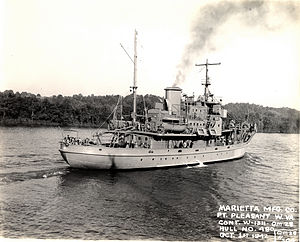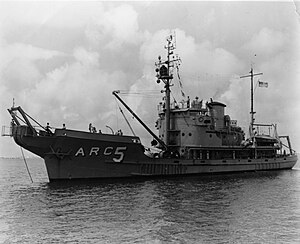
The USCG seagoing buoy tender is a type of United States Coast Guard Cutter used to service aids to navigation throughout the waters of the United States and wherever American shipping interests require. The U.S. Coast Guard has maintained a fleet of seagoing buoy tenders dating back to its origins in the U.S. Lighthouse Service (USLHS). These ships originally were designated with the hull classification symbol WAGL, but in 1965 the designation was changed to WLB, which is still used today.

The second USS Mackinac (AVP-13) was a United States Navy Barnegat-class small seaplane tender in commission from 1942 to 1947 that saw service during World War II. After the war, she was in commission in the United States Coast Guard from 1949 to 1967 as the cutter USCGC Mackinac (WAVP-371), later WHEC-371, the second ship of the Coast Guard or its predecessor, the United States Revenue Cutter Service, to bear the name.

Onionhead is a 1958 comedy-drama film set on a U.S. Coast Guard ship during World War II, starring Andy Griffith and featuring Felicia Farr, Walter Matthau, Erin O'Brien, James Gregory, Joey Bishop, and Claude Akins. It was directed by Norman Taurog and was written by Nelson Gidding and Weldon Hill from Hill's novel. Weldon Hill was the pseudonym of William R. Scott, a native Oklahoman who based the novel on his own World War II service in the Coast Guard.
USS Barricade (ACM-3) was a Chimo-class minelayer in the United States Navy during World War II.

USS Barbican (ACM-5) was a Chimo-class minelayer in the United States Navy. Barbican was later commissioned in U.S. Coast Guard as USCGC Ivy.
USS Bastion (ACM-6) was a Chimo-class minelayer in the United States Navy during World War II.
USS Obstructor (ACM-7) was a Chimo-class minelayer in the United States Navy during World War II.

USS Picket (ACM–8) was a Chimo-class minelayer of the United States Navy during World War II.

USS Biscayne (AVP-11), later AGC-18, was a United States Navy Barnegat-class seaplane tender in commission as a seaplane tender from 1941 to 1943 and as an amphibious force flagship from 1943 to 1946. She saw service during World War II. Transferred to the United States Coast Guard after the war, she was in commission as the Coast Guard cutter USCGC Dexter (WAGC-385), later WAVP-385 and WHEC-385, from 1946 to 1952 and from 1958 to 1968.

The third USS Casco (AVP-12) was a United States Navy Barnegat-class small seaplane tender in commission from 1941 to 1947. She saw service in World War II. After her decommissioning, the U.S. Navy loaned her to the United States Coast Guard, in which she served as the cutter USCGC Casco (WAVP-370), later WHEC-370, from 1949 to 1969.

USS Coos Bay (AVP-25) was a United States Navy Barnegat-class small seaplane tender in commission from 1943 to 1946 that saw service during the latter half of World War II. After the war, she was in commission in the United States Coast Guard from 1949 to 1966 as the cutter USCGC Coos Bay (WAVP-376), later WHEC-376.

USS Unimak (AVP-31) was a United States Navy Barnegat-class small seaplane tender in commission from 1943 to 1946 that saw service in World War II. After the war, she was in commission in the United States Coast Guard as the cutter USCGC Unimak (WAVP-379), later WHEC-379, WTR-379, and again WHEC-379, from 1949 to 1975 and from 1977 to 1988.

USS Seize (ARS-26) was a Diver-class rescue and salvage ship commissioned in the United States Navy during World War II. Her task was to come to the aid of stricken vessels.

USS Matagorda (AVP-22/AG-122) was a United States Navy Barnegat-class seaplane tender in commission from 1941 to 1946 that saw service in World War II. After the war, she was in commission in the United States Coast Guard as the cutter USCGC Matagorda (WAVP-373), later WHEC-373, from 1949 to 1967.
The first Dekanawida (YT-334/YTB-334) was a tug in the United States Navy during World War II.

USAMP Major General Wallace F. Randolph, sometimes also known as MG Wallace F. Randolph, was a 188.2-foot (57.4 m) mine planter built by the Marietta Manufacturing Company, and delivered to the United States Army Mine Planter Service in 1942. The ship was transferred to the U.S. Navy in 1951, placed directly into the Atlantic Reserve Fleet without being commissioned classed as the auxiliary minelayer ACM-15, then reclassified minelayer, auxiliary (MMA) and named MMA-15, and finally given the name Nausett without any active naval service. After being stricken from the Naval Vessel Register, the ship was transferred to different owners, and eventually was scuttled off the coast of Florida as an artificial reef and fish aggregating device. The site is currently known as the Thunderbolt Wreck, and is considered to be an excellent and challenging dive site for advanced divers.
USS J. A. Palmer (SP-319), later USS SP-319, was a United States Navy patrol vessel in commission between 1917 and 1919. The vessel was later USCGC Pequot in U.S. Coast Guard service.

The U.S. Army Mine Planter Service (AMPS) was an outgrowth of civilian crewed Army mine planter ships dating back to 1904. It was established on July 22, 1918 by War Department Bulletin 43 and placed the Mine Planter Service under the U.S. Army Coast Artillery Corps. Its purview was to install and maintain the underwater minefields that were part of the principal armament of U.S. coastal fortifications, including those at the approaches to the Panama Canal and the defenses of Manila Bay in the Philippines.
Camanche (ACM-11/MMA-11) was the name given in 1945 to the former U.S. Army Mine Planter (USAMP) Brigadier General Royal T. Frank (MP-12) while in naval inactive reserve more than ten years after acquisition of the ship by Navy from the Army in 1944. The ship had previously been classified by the Navy as an Auxiliary Mine Layer (ACM) and then Minelayer, Auxiliary (MMA). The ship was never commissioned by Navy and thus never bore the "USS" prefix.

Mine planter and the earlier "torpedo planter" was a term used for mine warfare ships into the early days of World War I. In later terminology, particularly in the United States, a mine planter was a ship specifically designed to install controlled mines or contact mines in coastal fortifications. This type of ship diverged in both function and design from a ship operating as a naval minelayer. Though the vessel may be seagoing it is not designed to lay large numbers of mines in open sea. A mine planter was designed to place controlled minefields in exact locations so that they might be fired individually or as a group from shore when observers noted a target to be at or near a designated mine's position. The terms and types of specialized ship existed from the 1860s where "torpedoes" were made famous in the American Civil War until the demise of large, fixed coastal fortifications brought on by the changes of World War II.














